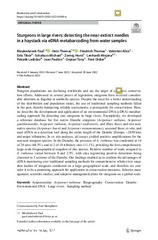Приказ основних података о документу
Sturgeons in large rivers: detecting the near‑extinct needles in a haystack via eDNA metabarcoding from water samples
| dc.creator | Meulenbroek, Paul | |
| dc.creator | Hein, Thomas | |
| dc.creator | Friedrich, Thomas | |
| dc.creator | Valentini, Alice | |
| dc.creator | Erős, Tibor | |
| dc.creator | Schabuss, Michael | |
| dc.creator | Zornig, Horst | |
| dc.creator | Lenhardt, Mirjana | |
| dc.creator | Pekarik, Ladislav | |
| dc.creator | Jean, Pauline | |
| dc.creator | Dejean, Tony | |
| dc.creator | Pont, Didier | |
| dc.date.accessioned | 2022-08-02T08:19:13Z | |
| dc.date.available | 2022-08-02T08:19:13Z | |
| dc.date.issued | 2022 | |
| dc.identifier.issn | 0960-3115 | |
| dc.identifier.uri | http://rimsi.imsi.bg.ac.rs/handle/123456789/1557 | |
| dc.description.abstract | Sturgeon populations are declining worldwide and are the target of extensive conservation efforts. Addressed in several pieces of legislation, sturgeons have received considerable attention as flagship or umbrella species. Despite the need for a better understanding of the distribution and population status, the use of traditional sampling methods failed in the past, thereby hampering reliable assessments, a prerequisite for conservation. Here, we describe the development and application of an environmental DNA (eDNA) metabarcoding approach for detecting rare sturgeons in large rivers. Exemplarily, we developed a reference database for five native Danube sturgeons (Acipenser stellatus, Acipenser gueldenstaedtii, Acipenser ruthenus, Acipenser nudiventris, and Huso huso) and two nonnative species (Acipenser baerii and Acipenser transmontanus), assessed these ex situ, and used eDNA as a detection tool along the entire length of the Danube (Europe, ~ 2850 km) and major tributaries. In ex situ analyses, all assays yielded positive amplifications for the assessed sturgeon species. In the Danube, the presence of A. ruthenus was confirmed at 14 of 29 sites (48.3%), and in 2 of 18 tributary sites (11.1%), providing the first comprehensive large-scale biogeographical snapshot of this species. Relative number of reads assigned to A. ruthenus varied between 0 and 2.5%, with sites registering positive detections being clustered in 3 sections of the Danube. Our findings enabled us to confirm the advantages of eDNA monitoring over traditional sampling methods for comprehensive whole-river snapshot studies of sturgeons conducted on a large geographical scale, and therefore we consider it to be a promising approach for application in conservation measures, fisheries management, scientific studies, and adaptive management plans for sturgeons on a global scale. | sr |
| dc.language.iso | en | sr |
| dc.publisher | Springer | sr |
| dc.relation | RIMECO (I 5006) | sr |
| dc.relation | ANN-OTKA 135082 | sr |
| dc.relation | EU COST Action DNAqua-Net (CA15219) | sr |
| dc.relation | INTERREG “MEASURES” program (DTP2-038–2.3) | sr |
| dc.relation | “LIFE-Sterlet” project | sr |
| dc.relation | info:eu-repo/grantAgreement/MESTD/inst-2020/200053/RS// | sr |
| dc.relation | info:eu-repo/grantAgreement/MESTD/inst-2020/200007/RS// | sr |
| dc.rights | openAccess | sr |
| dc.rights.uri | https://creativecommons.org/licenses/by/4.0/ | |
| dc.source | Biodiversity and Conservation | sr |
| dc.subject | Acipenseridae | sr |
| dc.subject | Acipenser ruthenus | sr |
| dc.subject | Biogeography | sr |
| dc.subject | Conservation | sr |
| dc.subject | Danube | sr |
| dc.subject | Environmental DNA | sr |
| dc.subject | Large rivers | sr |
| dc.subject | Sampling method | sr |
| dc.title | Sturgeons in large rivers: detecting the near‑extinct needles in a haystack via eDNA metabarcoding from water samples | sr |
| dc.type | article | sr |
| dc.rights.license | BY | sr |
| dc.citation.rank | M21~ | |
| dc.identifier.doi | 10.1007/s10531-022-02459-w | |
| dc.identifier.fulltext | http://rimsi.imsi.bg.ac.rs/bitstream/id/3757/Paul2022_Article_SturgeonsInLargeRiversDetectin.pdf | |
| dc.type.version | publishedVersion | sr |

